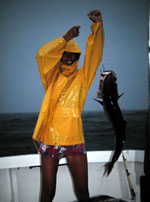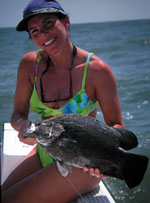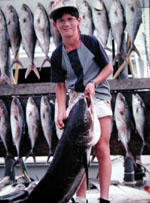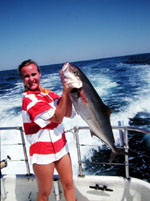
|
Features
|
|
|
|
Books
|
|
|
|
Fun & Games
|
|
|
|
Contact Us
|
|
|
John's Journal... Entry 149, Day 5
BOB EPSTEIN ON VACATION PHOTOS
10 Secrets For Best Vacation Photography
 EDITOR'S
NOTE: Bob Epstein of River Ranch, Florida, has worked as a professional
photographer and outdoor writer for years. He also represents Olympus
Cameras. He speaks throughout the nation on how to take better outdoor
photographs. This week, Epstein will tell us all how to take better vacation
and outdoors photography.
EDITOR'S
NOTE: Bob Epstein of River Ranch, Florida, has worked as a professional
photographer and outdoor writer for years. He also represents Olympus
Cameras. He speaks throughout the nation on how to take better outdoor
photographs. This week, Epstein will tell us all how to take better vacation
and outdoors photography.
* Most importantly -- practice, practice, practice. If you are using a digital camera, you don't have to worry about using up film. You can practice all you want, and get the best shots.
* Take plenty of images. You only get one chance to capture a moment. Don't be afraid to use up film -- of course like I said, if you have a digital camera, you don't have to worry about using up film. But if you have to use up a lot of film, don't worry about it because getting an excellent picture is well worth the film you use.
 *
Be aware of your lighting. Consider the combination and quantity of light
as well as contrast -- the range of the light and the color. At different
times of the day, the actual color of the light will change. Really consider
this fact when taking pictures. The best time of the day to take pictures
is early in the morning when you get the rim-light effect. Take pictures
when the sun is down and almost totally immersing the object, whether
it is a person, an animal or a fish. Rainy and overcast days can offer
flat, yet incredibly excellent lighting for some shots. On those rainy
days, your weather-proof camera comes in handy. Better quality point-and-shoot
cameras have nighttime settings, which allow you to take pictures of your
Christmas trees and Hanukkah candles and other memorable indoor and outdoor
scenes.
*
Be aware of your lighting. Consider the combination and quantity of light
as well as contrast -- the range of the light and the color. At different
times of the day, the actual color of the light will change. Really consider
this fact when taking pictures. The best time of the day to take pictures
is early in the morning when you get the rim-light effect. Take pictures
when the sun is down and almost totally immersing the object, whether
it is a person, an animal or a fish. Rainy and overcast days can offer
flat, yet incredibly excellent lighting for some shots. On those rainy
days, your weather-proof camera comes in handy. Better quality point-and-shoot
cameras have nighttime settings, which allow you to take pictures of your
Christmas trees and Hanukkah candles and other memorable indoor and outdoor
scenes.
* Get close, and then get even closer to the subject of your photo. Try not to include too much in the picture. Focus on a picture and not on a snapshot.
* Take careful measures to not make overweight people look too large. You want to pose everyone so they look their best. Never shoot overweight people from below. Step back a littler further than where you'd photograph most people, ask them to lean forward to avoid the appearance of a double chin.
* Get the light as high as possible if your subject has on glasses, when shooting in artificial light, so the light will not flare off the glasses.
 *
Work in the shade, and use your fill flash as much as possible when photographing
outside. Use your fill flash when you think there are shadows.
*
Work in the shade, and use your fill flash as much as possible when photographing
outside. Use your fill flash when you think there are shadows.
* Shoot in the shade, and avoid the harsh lighting to minimize the lines on an elderly subjects' face. Don't get too close when you are shooting an elderly person, and don't use contrasting film if you are using a film camera.
* Use great natural settings when photographing young subjects. Don't over-pose your children. Let them be playful. Dress them in bright, colorful clothing, and avoid direct, harsh sunlight in their faces.
* Take control as soon as possible when photographing groups. Pose them in a triangular shape. When photographing a group shot of your family, don't line up everyone in a row. Let some stand, some sit and some kneel. Vary the height of the people in your picture to make the shot look more interesting. The eye can dance around such an interesting photo.
* Take family portraits on your vacations. Find interesting locations like a rocky shore at the beach, a bench at the park, logs in the woods or fences surrounding a pasture. Dress everyone in a similar style and color of clothing to lead the viewers' eyes more to the expressions on people's faces.
 *
Turn your camera vertically when photographing one person or a couple
of people. When shooting a group of people, turn your camera horizontally.
When you use a camera vertically, you get a much more dramatic effect
when you focus in on the subject. Nothing is more popular in photography
than a portraiture. Whether you are taking a picture of a loved one or
people you encounter on your travels, capturing the pictures of a loved
one is both challenging and rewarding.
*
Turn your camera vertically when photographing one person or a couple
of people. When shooting a group of people, turn your camera horizontally.
When you use a camera vertically, you get a much more dramatic effect
when you focus in on the subject. Nothing is more popular in photography
than a portraiture. Whether you are taking a picture of a loved one or
people you encounter on your travels, capturing the pictures of a loved
one is both challenging and rewarding.
* Zoom in closer to the subjects you photograph if your other photos have turned out bad.
* Remember that what appears interesting as you look at the landscape in person, often looks terrible in a picture. Sometimes a landscape photo can have too many subjects, flat lighting and look bad.
* Shoot lots of pictures, get close, get closer, vary your angles and shoot the action.
For more information on Bob Epstein's book "How To Take Your Best Shot With A Point-and-Shoot Camera," e-mail him at bobepstein@aol.com. The book costs $4.95 with postage included.
Check back each day this week for more Bob Epstein on Vacation Photos ...
Day 1 - Buying a Camera
Day 2 - Most Common Mistakes
Day 3 - The Joy Of A Digital Camera
Day 4 - Five Tips For Shooting Better Digital
Photography For The Outdoors
Day 5 - 10 Secrets For Best Vacation Photography